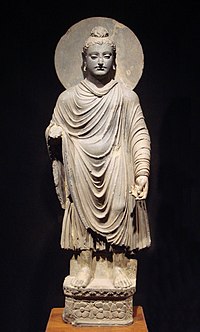"Sek-khia-mô͘-nî" pán-pún chi-kan bô-kāng--ê tē-hng
刪去的內容 新增的內容
| Tē 23 chōa: | Tē 23 chōa: | ||
* {{Harvard citation text|Buddhadasa|2017|p=5}} gives several translations, including "the knowing one": "This is how we understand "Buddha" in Thailand, as the Awakened One, the Knowing One, and the Blossomed One."}}--> |
* {{Harvard citation text|Buddhadasa|2017|p=5}} gives several translations, including "the knowing one": "This is how we understand "Buddha" in Thailand, as the Awakened One, the Knowing One, and the Blossomed One."}}--> |
||
<!-- "Buddha-statue" --> |
<!-- "Buddha-statue" --> |
||
<!--{{refn|group="note"|name="Buddha-statue"|Buddha is seated cross-legged in the [[lotus position]]. In the centre of the base relief is a wheel symbolizing the ''[[dharmachakra]]'', the Wheel of Buddhist law, with [[Attitude (heraldry)#Couchant|couchant]] deer on either side symbolizing the deer park in which the sermon was preached. The fingers of his hands form the [[Mudra#Dharmachakra Pravartana Mudrā|teaching pose]]. |
<!--{{refn|group="note"|name="Buddha-statue"|Buddha is seated cross-legged in the [[lotus position]]. In the centre of the base relief is a wheel symbolizing the ''[[dharmachakra]]'', the Wheel of Buddhist law, with [[Attitude (heraldry)#Couchant|couchant]] deer on either side symbolizing the deer park in which the sermon was preached. The fingers of his hands form the [[Mudra#Dharmachakra Pravartana Mudrā|teaching pose]]. |
||
* {{Harvard citation text|Sahni|1914|pp=70–71, chapter B (b) 181}}: "Image (ht 5' 3'' up to the top of the halo; width at base 2' 7'') of Gautama Buddha seated cross-legged, preaching the first sermon at Sarnath, on a thick cushion supported on a seat with moulded legs." |
* {{Harvard citation text|Sahni|1914|pp=70–71, chapter B (b) 181}}: "Image (ht 5' 3'' up to the top of the halo; width at base 2' 7'') of Gautama Buddha seated cross-legged, preaching the first sermon at Sarnath, on a thick cushion supported on a seat with moulded legs." |
||
* {{Harvard citation text|Eck|1982|p=63}}: In the most famous of these images in the Sarnath museum, the Buddha sits cross-legged, his limbs in the perfect proportions prescribed by the iconometry of the day, his hands in a teaching pose, his eyes downcast, half-shut in meditation, his head backed by a beautifully ornamented circular nimbus." |
* {{Harvard citation text|Eck|1982|p=63}}: In the most famous of these images in the Sarnath museum, the Buddha sits cross-legged, his limbs in the perfect proportions prescribed by the iconometry of the day, his hands in a teaching pose, his eyes downcast, half-shut in meditation, his head backed by a beautifully ornamented circular nimbus." |
||
* {{Harvard citation text|Mani|2012|pp=66–67}}: "The seated Buddha, B(b) 181 showing Buddha cross-legged in the attitude of preaching, is one of the most exquisite creations of Gupta art. The halo is carved with a pair of celestial figures and conventionalized floral scroll-work."}} |
* {{Harvard citation text|Mani|2012|pp=66–67}}: "The seated Buddha, B(b) 181 showing Buddha cross-legged in the attitude of preaching, is one of the most exquisite creations of Gupta art. The halo is carved with a pair of celestial figures and conventionalized floral scroll-work."}}--> |
||
<!-- "Buswell_Lopez_renunciation" --> |
<!-- "Buswell_Lopez_renunciation" --> |
||
<!--* {{refn|group=note|name="Buswell_Lopez_renunciation"|{{harvnb|Buswell Jr.|Lopez Jr.|2014|p=entry "Sakyamuni"}} refer to the [https://www.accesstoinsight.org/tipitaka/mn/mn.026.than.html Ariyapariyesana Sutta], noting: "Buddha’s quest for enlightenment occurs in the ARIYAPARIYESANĀSUTTA. It is noteworthy that many of the most familiar events in the Buddha’s life are absent in some of the early accounts."<br>The Ariyapariyesana Sutta says: "So, at a later time, while still young, a black-haired young man endowed with the blessings of youth in the first stage of life — and while my parents, unwilling, were crying with tears streaming down their faces — I shaved off my hair & beard, put on the ochre robe and went forth from the home life into homelessness.}}--> |
<!--* {{refn|group=note|name="Buswell_Lopez_renunciation"|{{harvnb|Buswell Jr.|Lopez Jr.|2014|p=entry "Sakyamuni"}} refer to the [https://www.accesstoinsight.org/tipitaka/mn/mn.026.than.html Ariyapariyesana Sutta], noting: "Buddha’s quest for enlightenment occurs in the ARIYAPARIYESANĀSUTTA. It is noteworthy that many of the most familiar events in the Buddha’s life are absent in some of the early accounts."<br>The Ariyapariyesana Sutta says: "So, at a later time, while still young, a black-haired young man endowed with the blessings of youth in the first stage of life — and while my parents, unwilling, were crying with tears streaming down their faces — I shaved off my hair & beard, put on the ochre robe and went forth from the home life into homelessness.}}--> |
||
2022-nî 8-goe̍h 19-ji̍t (pài-gō·) 20:28 ê siu-tēng-pún

Sek-khia-mô͘-nî (Hàn-jī: 釋迦牟尼; Hôan-bûn:शाक्यमुनि, Śākyamuni), he̍k-chiá kiò Sek-khia-mô͘-nî-hu̍t, Sek-khia-hu̍t, gôan-miâ Siddhārtha Gautama (सिद्धार्थ गौतम), sī Hu̍t-kàu ê chhòng-sí-jîn. Sêng-hu̍t chi-āu pī chun-chheng hu̍t-tô, bîn-kan iā chhiâng-chāi chheng chò Hu̍t-chó͘, ì-sù sī thiat-ngō͘ í-tiū, jîn-seng chin-siòng chiá.
I chhut-sì kap koè-sin ê ji̍t-chí bô chin khak-tēng, tāi-iok sī chêng 563 nî kap chêng 483 nî, mā ū lâng jîn-ûi i sī 411 nî chó-iū koè-sin.
Tsù-sik
- ↑ Some sources mention Kapilavastu as the birthplace of the Buddha. Gethin states: "The earliest Buddhist sources state that the future Buddha was born Siddhārtha Gautama (Pali Siddhattha Gotama), the son of a local chieftain—a rājan—in Kapilavastu (Pali Kapilavatthu) what is now Nepal."Gethin 1998, p. 14 Gethin does not give references for this statement.
<references> 中定義的 <ref> 標籤設定 name 屬性為 "birthplace",但在前文中並未使用。Tsù-kái
- ↑ "Lumbini, the Birthplace of the Lord Buddha". World Heritage Convention. UNESCO. 26 May 2011 khòaⁿ--ê.
- ↑ "The Astamahapratiharya: Buddhist pilgrimage sites". Victoria and Albert Museum. goân-loē-iông tī 31 October 2012 hőng khó͘-pih. 25 December 2012 khòaⁿ--ê.
Guā-pōo lên-ket
| Wikisource has original works written by or about: Sek-khia-mô͘-nî |
- [1] tī Project Gutenberg ê chok-phín
- Buddha tī Internet Archive ê chok-phín
- Siddhārtha Gautama tī Internet Archive ê chok-phín
- Shakyamuni tī Internet Archive ê chok-phín
- Works by Sek-khia-mô͘-nî at LibriVox (public domain audiobooks)

- Buddha on In Our Time at the BBC
- A sketch of the Buddha's Life
- What Was The Buddha Like? by Ven S. Dhammika
- Parables and Stories of Buddha Archived 9 March 2022 at the Wayback Machine.
- Who was the Buddha? Buddhism for Beginners

